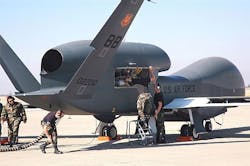Western Pacific is becoming a dense concentration of unmanned surveillance assets
Military rivalries along China's coast are transforming the region into a rare concentration of military unmanned vehicle technology, as global powers China and the United States, as well as regional powers like Japan and South Korea, step up their long-range surveillance capabilities in the air and at sea.
The South China Sea and East China Sea, north and south of Taiwan, represent serious global military flash points as China expands its military forces into international waters, builds modern aircraft carriers, boosts anti-aircraft and anti-ship defenses, and maintains its potential threats against Taiwan.
As a result the U.S. is stepping-up its freedom-of-navigation operations at sea and in the air, with frequent military overflights of the region -- including flights by strategic bombers like the B-1 and B-52, as well as by strategic reconnaissance planes like the P-8A Poseidon.
U.S. military forces also are keeping a close eye on the region with the Northrop Grumman RQ-4 Global Hawk and MQ-4C Triton long-range unmanned aerial vehicles (UAVs), as well as with manned surveillance aircraft like the Poseidon -- a militarized Boeing 737 passenger jet modified for maritime patrol missions.
Although less visible, the U.S. Navy is deploying a variety of unmanned maritime vehicles, including unmanned submarines like the General Dynamics Knifefish, as well as unmanned underwater gliders that can cover vast distances with minimal on-board power.
Two years ago China's navy captured a U.S. unmanned underwater glider in the South China Sea. The UUV, which the Pentagon said was operating lawfully in the Western Pacific and was clearly marked as U.S. property, was collecting data about the salinity, temperature, and clarity of the water about 50 nautical miles northwest of Subic Bay, Philippines, when it was taken.
It's likely this unmanned underwater craft was gathering more information than just water salinity, temperature, and clarity, although the UUV's precision mission almost certainly is classified. It most likely had to do with helping keep the military balance in the region. China reportedly returned the UUV after examining it.
This is probably not the last incident of its kind, as use of unmanned surveillance equipment only can become more widespread. China, also, reportedly is increasing its military use of unmanned aircraft and submarines to keep tabs on the region.
As time goes on, moreover, it won't be just the U.S. and China operating unmanned reconnaissance assets in the Western Pacific. Japan and South Korea are about to get into the game, too.
In December 2014 the Republic of Korea placed a $657.4 million order with Northrop Grumman through the U.S. Air Force for four RQ-4B Block 30 Global Hawk long-range UAVs. It reportedly was the first sale of the unmanned aircraft to an allied nation in the Asia Pacific region under the Foreign Military Sales process. Deliveries could start as early as this year.
In addition, and just this month, the government of Japan placed a $489.9 million order with Northrop Grumman, also through the Air Force, for three RQ-4 Global Hawk Block 30i long-range surveillance UAVs. Global Hawk deliveries to Japan could start by 2022.
The Global Hawk is a serious UAV. It's big -- 47.6 feet long, with a wingspan of 130.9 feet. It can fly as high as 60,000 feet, can carry surveillance sensor payloads as heavy as 3,000 pounds, and can fly for as long as 32 hours on one load of fuel. They also cost upwards of $150 million apiece.
With heavy iron like the Global Hawk deployed by several different nations in the region, the Western Pacific is bound to get more tense, more unstable, and more dangerous. Not to be a pessimist, but this is the kind of environment where things easily and quickly could get out of control.
Ready to make a purchase? Search the Military & Aerospace Electronics Buyer's Guide for companies, new products, press releases, and videos
